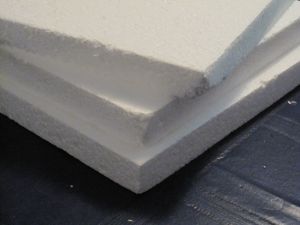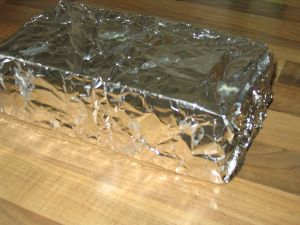Insulation
Insulation is needed to keep a colony warm and reduces the consumption of energy for heating. Aerogel or plastic foam may be utilized for insulation. Regolith may be heaped over buildings to keep in heat. Mineral wools, spun from local resources, may provide a lower tech alternative insulation. Fiberglass, a type of mineral wool, is commonly used as insulation on Earth. Arsenic is a mineral that can be used as a heat tolerant insulation, but is toxic to life.
Contents
Insulation on Mars
The thin Martian atmosphere has a reduced capability for a convective flow of heat. More important is the heat radiation, which can be effectively reduced by choosing the material of the building's surface. A smooth bright metallic surface emits much less heat radiation than a rough black one. A simple aluminium coated foil wrapped around the settlement modules provides excellent insulation. Multi-layer insulation (MLI) of the same type of foil can reduce heat loss to very low numbers and is commonly used for satellites. However, convection is still significant in insulation systems on Mars and this reduces the effectiveness of MLI[1].
Foam glass is another form or insulation than can be produced locally and should have superior insulation properties,as well as good structural properties. Foam insulation on Mars has very low convection and radiation rates. The heat transfer comes essentially from conduction in the cell walls.
Fiberglass and mineral wool would not function as insulators in the same way on Mars as they do on Earth. Fiberglass is not itself an insulator. The insulation comes from the thermal resistance of the air in the fiberglass mat. The resistance of the air in increased because it cannot flow freely over the surfaces, reducing convective heat transfer significantly. Fiberglass is also installed with a reflective vapor barrier, that adds to its insulation value.
Insulation table
The following table shows some insulation values for materials on Mars[1]. The exact value will need to be tested on Mars, and will vary significantly if the material is used inside a habitat at Earth atmospheric pressure or outside the habitat at martian atmospheric pressure.
| Material | Thermal conductivity (W/m/C) | Density
kg/m3 |
Embodied energy (MJ/kg) | Notes |
|---|---|---|---|---|
| Multi layer insulation | This insulation's effectiveness varies with the number of layers. No mechanical strength. Sensitive to convection | |||
| Foam glass | 0,038 | 160 | Might be produced in-situ. Relatively high mechanical strength | |
| Fiber glass | 0,01 to 0,02 | 7-12[2] | ||
| Foam | 0,02 to 0,04 | 20-30 | +100 MJ/kg | Might have problems from outgassing. Some mechanical strength |
| Mineral wool | 0,01 to 0,02 | No mechanical strength | ||
| Aerogel | 0,005 to 0,01 | 16 | ||
| Regolith | 1600-2200 |
Tank insulation
Insulation of fuel tanks on Mars may be a requirement to prevent accumulation of frozen CO2 on tanks. CO2 freezes a little bellow -67C and could accumulate significant mass on a fuel tank. Tank insulation needs to have a vapor barrier, or be composed of closed cells to avoid the risk of condensation in the insulation and the accumulation of water or CO2 ice in the material.
Oxygen
Methane
Hydrogen
Production
Insulation can be produced in-situ. The very low atmospheric pressure of Mars already provides a good insulation, reducing heat transfer from convection.
Foam glass would be an interesting type of insulation to produce on Mars. The resources, mainly silica oxide, are available in large quantities. An adequate foaming agent would need to be identified and mined and the production process refined to create a viable product.
Fiber glass and mineral wool can both be produced in-situ.
Open issue
- What is the heat transfer coefficient of regolith, aerogel and other materials?
- What can be produced in-situ with low energy consumption?









